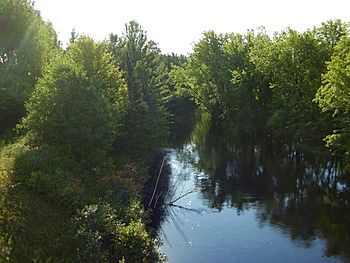Pelican River (Wisconsin River tributary) facts for kids
Quick facts for kids Pelican River |
|
|---|---|

Pelican River from highway 17 bridge.
|
|
| Country | United States |
| Location | Oneida County, Wisconsin |
| Physical characteristics | |
| Main source | Pelican Lake 45°31′36″N 89°12′22″W / 45.526626°N 89.206232°W |
| River mouth | Oneida County, Wisconsin 1,526 feet (465 m) 45°37′48″N 89°25′34″W / 45.629956°N 89.426242°W |
The Pelican River is a beautiful river located in Oneida County, Wisconsin. It starts its journey from Pelican Lake. The river then flows until it joins the much larger Wisconsin River in the city of Rhinelander.
Contents
The Pelican River's Journey
The Pelican River begins in Pelican Lake. This lake is a popular spot for fishing and boating. From there, the river flows through different landscapes. It passes through forests and open areas. Finally, it reaches its end point. This is where it meets the Wisconsin River. This meeting point is called a confluence. It happens in Rhinelander, a city known for its paper mills and outdoor activities.
Historical Importance
Long ago, the Pelican River was very important. It served as a travel route for the Pelican Lake Band of the Ojibwe Indians. They used the river like a highway. It helped them travel to places like Lac du Flambeau. This allowed them to connect with other Ojibwe communities. It was a vital path for trade and communication.
Nature and Wildlife
Rivers like the Pelican River are home to many plants and animals. Fish, birds, and other wildlife depend on healthy rivers. The river's waters support different types of fish. You might see birds like ducks and geese near its banks. Sometimes, even larger animals come to the river to drink. Protecting rivers helps keep these animals safe.
Fun Facts About Rivers
- Rivers are natural flowing watercourses. They usually flow towards an ocean, sea, lake, or another river.
- The place where a river starts is called its source.
- The place where a river ends is called its mouth.
- Rivers are important for many reasons. They provide drinking water. They also help with transportation and recreation.

